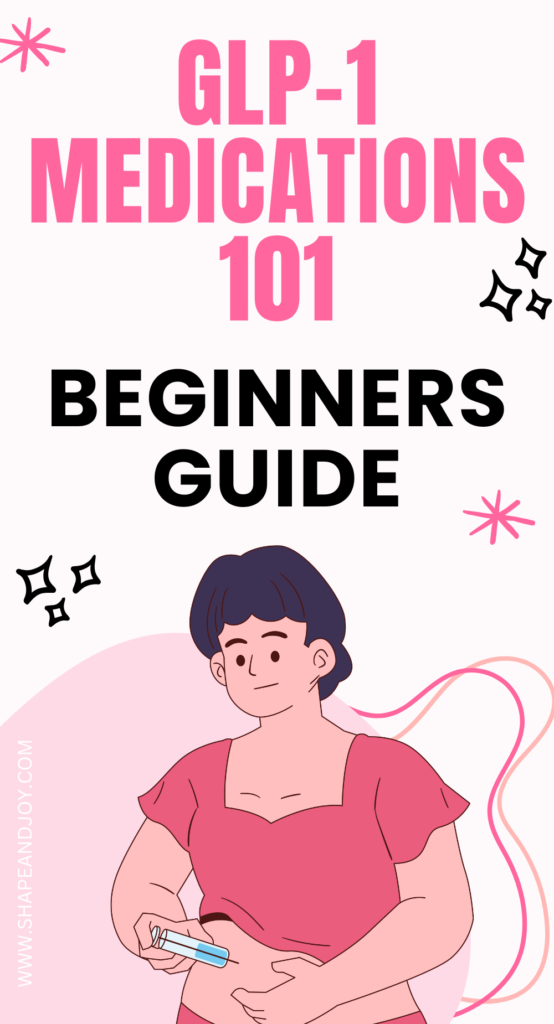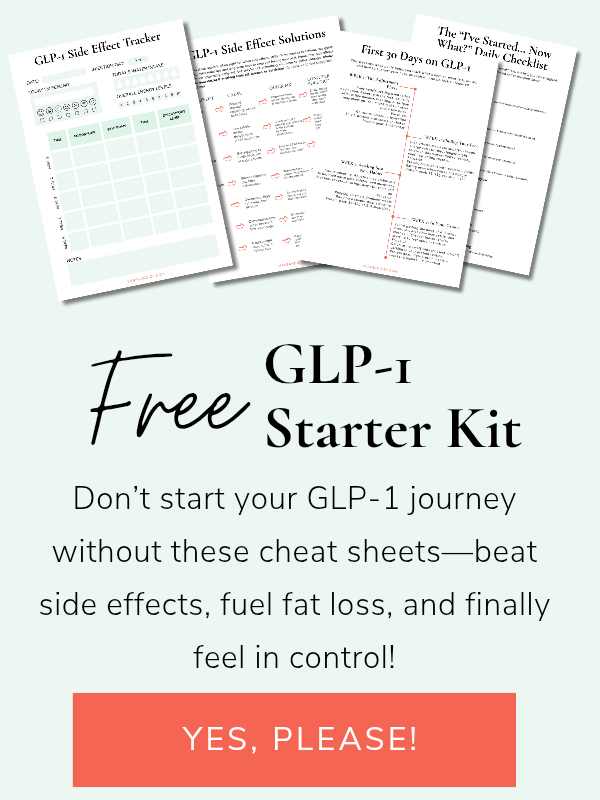This post may contain affiliate links, which means that I may earn a commission if you click on the link or make a purchase using the link. When you make a purchase, the price you pay will be the same whether you use the affiliate link or go directly to the vendor’s website using a non-affiliate link.

So, you’ve heard about GLP-1 medications—Ozempic, Mounjaro, Zepbound, and the rest of the gang—and now you’re wondering what all the fuss is about. Do they actually work?
Are they some kind of magic weight loss potion? And most importantly—what the hell can you eat while on them?
Buckle up, because we’re about to break it all down in a way that actually makes sense. No boring medical jargon, just real talk about what GLP-1s do, how they help with losing weight, and what you need to know before jumping in.
What Are GLP-1 Medications?
Let’s start with the basics: GLP-1 receptor agonists (catchy, right?) are a type of medication that was originally created to treat type 2 diabetes.
But, surprise surprise, they also happen to be brilliant at curbing appetite, regulating blood sugar, and helping people lose weight without feeling like they’re constantly at war with their fridge.
Some of the most well-known GLP-1 medications include:
- Mounjaro – Also known as Tirzepatide, a bit of a powerhouse when it comes to fat loss.
- Zepbound – The new kid on the block, and let’s just say it means business.
- Ozempic/Wegovy – The classics, famous for reducing appetite and stabilising blood sugar.
These bad boys work with your body to keep hunger levels in check, so you don’t feel like you need to eat your entire kitchen at 9 pm. Sounds dreamy, right?
How Do GLP-1s Actually Work?
Here’s the science-y bit—but don’t worry, I’ll keep it simple. GLP-1 medications mimic a natural hormone in your body called glucagon-like peptide-1 (hence the fancy name). This hormone does three big things:
- Slows down digestion – You feel full for longer, which means no more wandering into the kitchen just because you’re bored.
- Tells your brain you’re satisfied – Bye-bye mindless snacking!
- Regulates blood sugar – Less sugar crashing, more steady energy.
The result? Weight loss that actually feels manageable.
And because you’re naturally eating less, it’s much easier to stick to an easy meal plan for the week, whether you’re following a vegetarian diet, looking for vegan recipes, or just trying to keep things balanced with a high-protein approach.
Checkout my post ‘The Ultimate GLP-1 Meal Plan: Easy, Protein-Packed Meals for Weight Loss‘ for some meal plan ideas!
The Perks of GLP-1 Medications (a.k.a. Why Everyone’s Talking About Them)
Alright, let’s get into the juicy benefits of being on one of these meds:
✔ Effortless portion control – No more battling your willpower at every meal.
✔ Steady, sustainable weight loss – This isn’t some crash diet nonsense.
✔ Improved metabolism – Your body gets better at handling food, instead of storing every bite as fat.
✔ Better blood sugar control – Whether you have diabetes or not, it’s a win-win.

Side Effects: The Not-So-Fun Part
Alright, I won’t sugarcoat it—GLP-1s come with a bit of a learning curve. Some of the most common side effects include:
- Nausea – Your stomach might need time to adjust, especially in the first few weeks.
- Digestive issues – Think bloating, constipation, or (on the flip side) running for the loo.
- Fatigue – Because your body is adjusting to eating less.

The good news? Most of these symptoms settle down over time, and there are ways to manage them. Check out my post ‘8 Foods to Avoid If You’re Serious About Thriving on GLP-1 Medications‘ for tips on minimising side-effects!
Keeping your meals light but nutrient-dense can help—think GLP-1 breakfast ideas like scrambled eggs with avocado, Greek yoghurt with berries, or a high-protein smoothie.
📌 Pin this for later! ⬇

Who Should (and Shouldn’t) Use GLP-1s?
Not everyone needs a GLP-1, and they’re not a “get skinny quick” pill (because let’s be real, that doesn’t exist). These meds are best suited for:
- People who have struggled with weight loss for years and need extra support.
- Those with a high BMI or weight-related health issues like insulin resistance.
- Anyone looking for a long-term lifestyle change, not just a quick fix.
Who shouldn’t take them?
- People who just want to drop a few pounds for a holiday.
- Those with a history of certain thyroid conditions or pancreatitis.
- Anyone looking for a way to avoid healthy eating altogether (you’ll still need to make smart food choices!).
What to Expect When You Start GLP-1s
If you’re thinking of trying Mounjaro, Wegovy or Zepbound, here’s what the first few weeks might look like:
Week 1-2: Appetite starts to drop, but nausea might kick in. Stick to easy-to-digest foods (GLP-1 diet recipes with high protein and fibre help!).
Week 3-4: Cravings lessen, portions shrink naturally, and energy stabilises.
Month 2+: Weight loss starts to show, and side effects improve.
It’s also a great time to build solid eating habits that focus on high-protein, fibre-rich meals.
Next Steps:
Still not sure which one is right for you?
- Grab my free GLP-1 Kickstart Bundle to help you get started on the right foot!
- Read: How to Qualify for GLP-1s if you’re not sure whether you’re eligible — or what the next steps are in the UK or US.
- Or dive into the GLP-1 Nutrition Guide to start eating for results
Final Thoughts: Is a GLP-1 Right for You?
GLP-1 medications aren’t a magic fix, but they are an incredible tool for making weight loss feel easier, more natural, and actually sustainable.
If you’re fed up with extreme dieting and want something that actually works with your body, then it might be worth chatting with your doctor about GLP-1s.
And remember—these meds work best when paired with the right food choices. So, whether you’re looking for foods to eat on Wegovy, curious about GLP-1 meal recipes, or just need easy meal ideas, I’ve got you covered in the rest of this GLP-1 series.
📌 Pin this for later! ⬇



